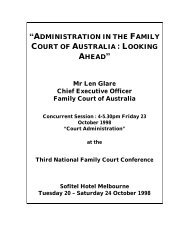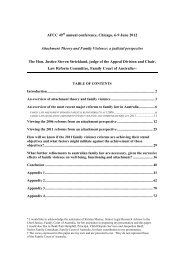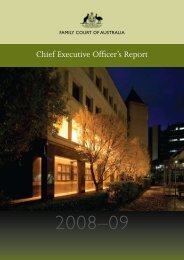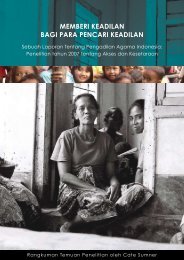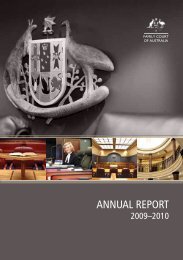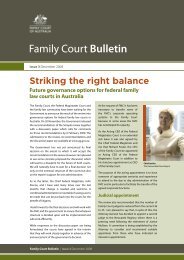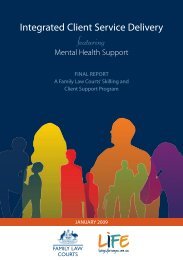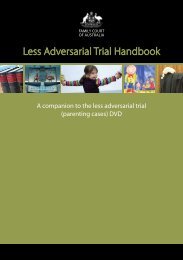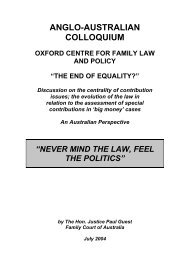Providing Justice to the Justice Seeker: - Family Court of Australia
Providing Justice to the Justice Seeker: - Family Court of Australia
Providing Justice to the Justice Seeker: - Family Court of Australia
- No tags were found...
You also want an ePaper? Increase the reach of your titles
YUMPU automatically turns print PDFs into web optimized ePapers that Google loves.
The Religious <strong>Court</strong>s hear two types <strong>of</strong> divorce cases, each with different requirements. The firstis a divorce initiated by <strong>the</strong> husband (cerai talak) and <strong>the</strong> second is a divorce initiated by <strong>the</strong>wife (cerai gugat). 67% <strong>of</strong> divorce cases decided in 2009 by <strong>the</strong> Religious <strong>Court</strong>s were initiatedby <strong>the</strong> wife. 22The Population Administration Law fur<strong>the</strong>r requires that a divorce be registered within 60days from <strong>the</strong> date that <strong>the</strong> divorce judgment is final and binding. 23 A party <strong>to</strong> a divorce in<strong>the</strong> General <strong>Court</strong>s must bring a copy <strong>of</strong> <strong>the</strong> divorce judgment <strong>to</strong> <strong>the</strong> Civil Registry so thatit can be noted on <strong>the</strong> Divorce Register and a divorce certificate issued. The Religious <strong>Court</strong>showever, print and issue divorce certificates once <strong>the</strong> divorce judgment has become final andbinding. 24 The Registrar <strong>of</strong> <strong>the</strong> Religious <strong>Court</strong>s conveys a copy <strong>of</strong> <strong>the</strong> court judgment <strong>to</strong> <strong>the</strong>Civil Registry within 30 days <strong>of</strong> it becoming final and binding. 25 Both court clients and lawyersexpressed <strong>the</strong> view that <strong>the</strong> extra step required for General <strong>Court</strong>s clients <strong>to</strong> take <strong>the</strong> judgment<strong>to</strong> <strong>the</strong> Civil Registry within 60 days means that in many cases <strong>the</strong> time period elapses and itbecomes problematic <strong>to</strong> register <strong>the</strong> divorce at <strong>the</strong> Civil Registry.In 2009, over 13,000 cases were received by <strong>the</strong> Religious <strong>Court</strong>s concerning marriagelegalisation (itsbat nikah cases) in which <strong>the</strong> Religious <strong>Court</strong>s provide <strong>the</strong> applicant with adocument evidencing an earlier marriage. 26 This document can <strong>the</strong>n be used at <strong>the</strong> civil registry<strong>to</strong> obtain o<strong>the</strong>r documents, including birth certificates.Legal process for obtaining a birthcertificateUNICEF Indonesia states that:Approximately 60 per cent <strong>of</strong> Indonesian children under-five years <strong>of</strong> age do not have birthcertificates and half are not registered anywhere. This represents one <strong>of</strong> <strong>the</strong> lowest birth registrationlevels <strong>of</strong> any country in <strong>the</strong> region.Birth registration is a fundamental human right and an essential means <strong>of</strong> protecting a child’sright <strong>to</strong> <strong>the</strong>ir identity. Registering a birth serves as an effective civil mechanism that legallyacknowledges a person’s existence, enables a child <strong>to</strong> possess a birth certificate, establishes <strong>the</strong>child’s family ties, and tracks life’s major miles<strong>to</strong>nes from birth through marriage and death.Birth registration also helps governments <strong>to</strong> track <strong>the</strong>ir country’s demographic statistics, healthtrends and differentials. Comprehensive data means more accurate planning and implementation<strong>of</strong> development policies and programs, particularly in <strong>the</strong> fields <strong>of</strong> health, education, housing,water, sanitation and employment… 2722 Badilag (2010) E-pr<strong>of</strong>ile for <strong>the</strong> Religious <strong>Court</strong>s 2009. Of 223,371 divorce cases decided in 2009, 149,240 wereinitiated by women and 74,131 by men.23 Article 40, Law 23 <strong>of</strong> 2006 on Administrasi Kependudukan.24 A decision is final and binding 14 days after it has been read out in court before both parties. If both parties arenot present in court, <strong>the</strong>n <strong>the</strong> decision becomes final and binding 14 days after it has been delivered <strong>to</strong> <strong>the</strong>parties (Law 7/1989, article 54 and HIR articles 128 and 129 (2)). If respondent party cannot be found, <strong>the</strong> courtsends <strong>the</strong> decision <strong>to</strong> <strong>the</strong> Head <strong>of</strong> District (Bupati/Walikota) <strong>to</strong> publish in his/her <strong>of</strong>fice. HIR article 390 (3).25 Undang-Undang no.7 1989 concerning <strong>the</strong> Religious <strong>Court</strong>s, Article 84 .26 Islamic Law Compilation Book 1 (concerning marriage), Article 7 and Law 23 <strong>of</strong> 2006 concerning PopulationAdministration, Article 36.27 UNICEF: Overview - Birth Registration for all, http://www.unicef.org/indonesia/protection_2931.html.24 <strong>Providing</strong> <strong>Justice</strong> <strong>to</strong> <strong>the</strong> <strong>Justice</strong> <strong>Seeker</strong> A Report on <strong>the</strong> Access and Equity Study in <strong>the</strong>Indonesian General and Religious <strong>Court</strong>s 2007–2009



